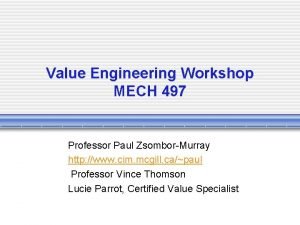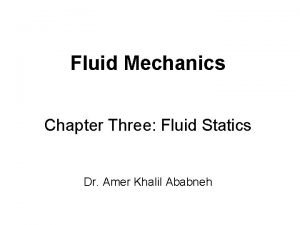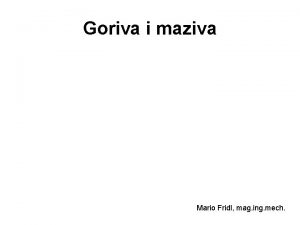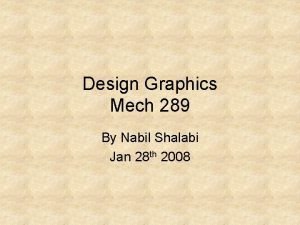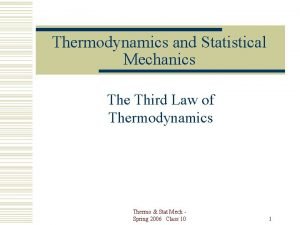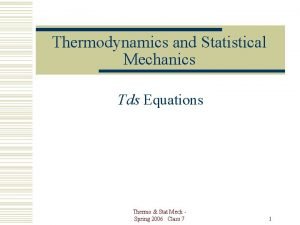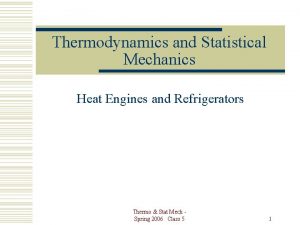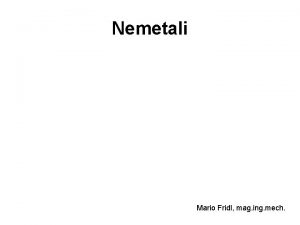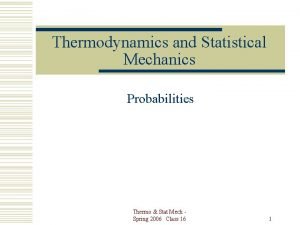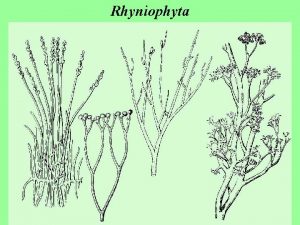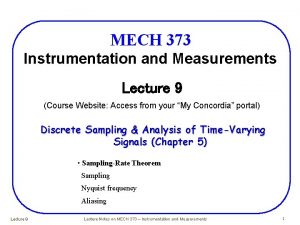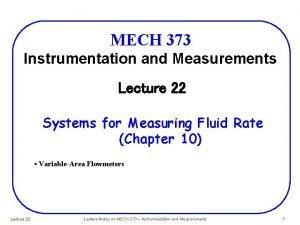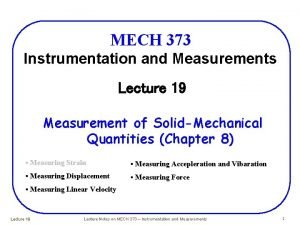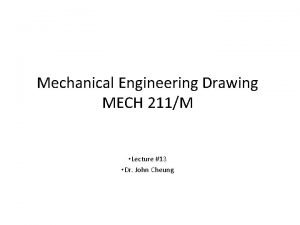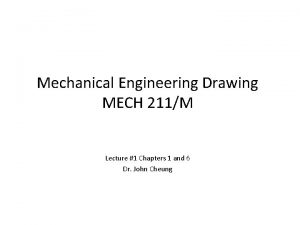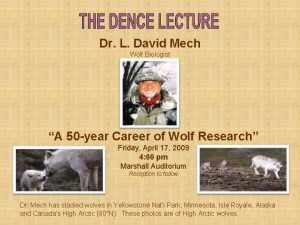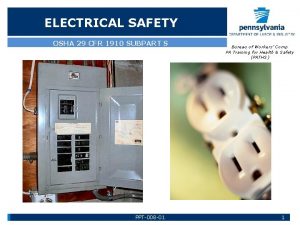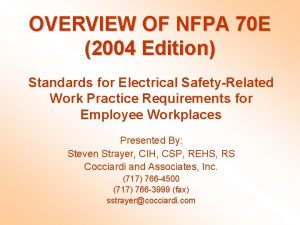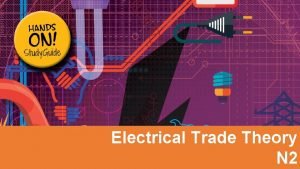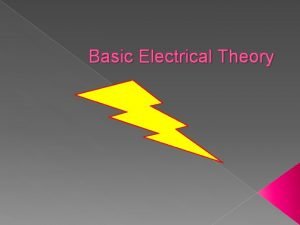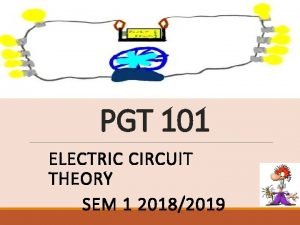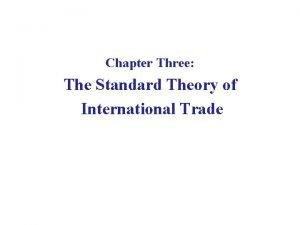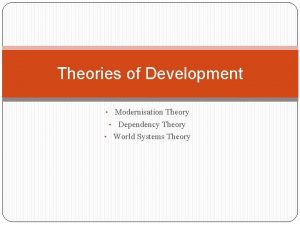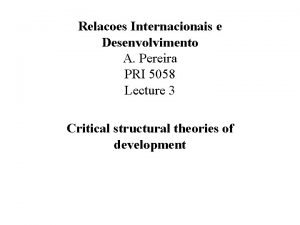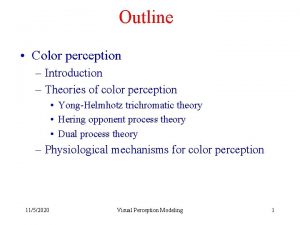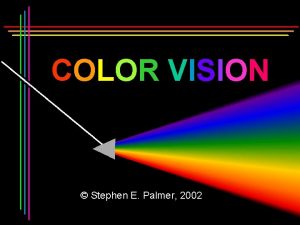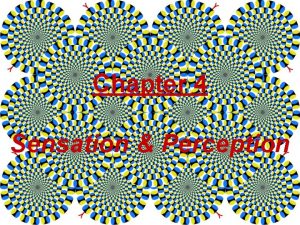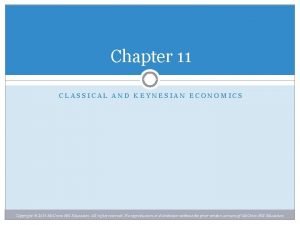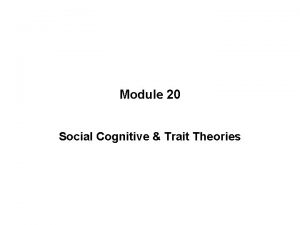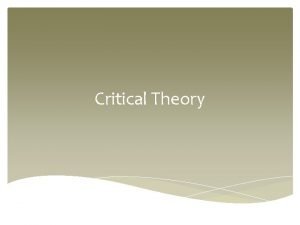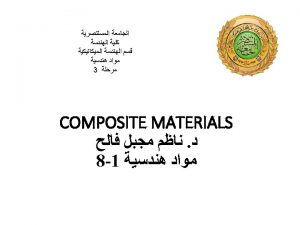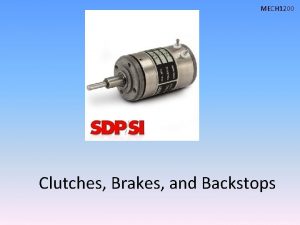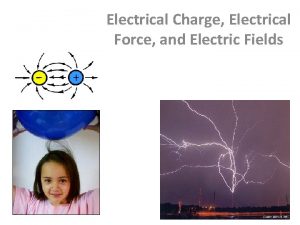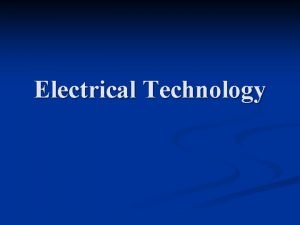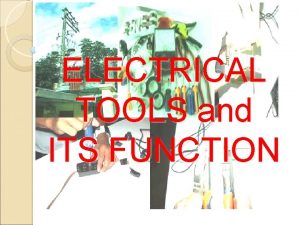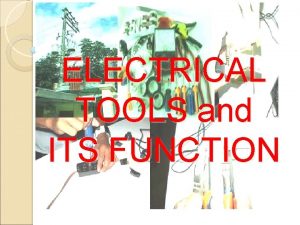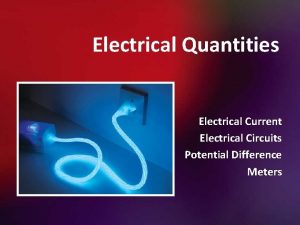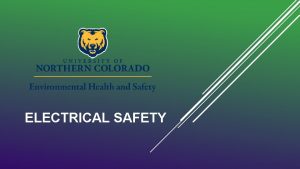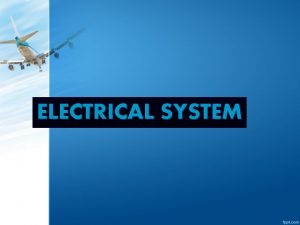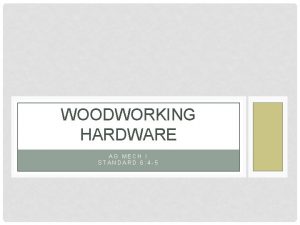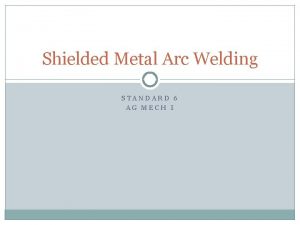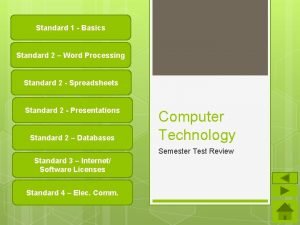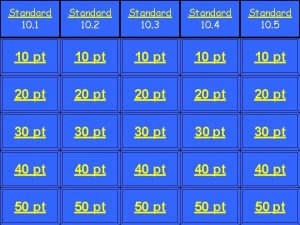Electrical Terminology Theory Ag Mech I Standard 7























































- Slides: 55

Electrical Terminology & Theory Ag Mech I Standard 7: 1 -7

Terminology • Electricity-form of energy that can produce light, heat, magnetism and chemical changes • Filament-special metal element that can produce light by heating it in a vacuum tube called a bulb • Fluorescent light- glows as a result of electricity flowing through a gas • Resistance-any tendency of a material to prevent electrical flow • Conductor-metal that allows electricity to flow easily (silver, copper then alumnium • Insulator-material that provides great resistance to the flow of electricity • Amperes- measure of the rate of flow of electricity • Volts-measure of electrical pressure

Terminology • Watts-measure of the amount of energy or work that can be done by amps and volts • Ohm-unit used to measure a materials resistance to the flow of electrical current • Ohm’s law- the relationship between electric current, electromotive force and resistance formula is E=IR Volts(E), Amps(I) and resistance(R) • Volt-ohm-millampere meter-popular meter that measures volts, ohms, and amps • Milliampere-one thousandth of an amp • Magnetism-force that attracts or repels iron or steel • Permanent Magnet-if iron or steel holds its magnetism

Terminology • Poles-the 2 ends of a magnet • North pole-the end of a magnet that attracts the south pole of a magnet but repels the north pole • Attraction-part of a magnet that pulls metal in its direction • Repulsion-part of a magnet that repels metal • South pole-the end of a magnet that repels the south pole of a magnet but attracts the north pole • Magnetic flux-lines of magnetic force that occur in the air between 2 poles • Magnetic field-the pattern of a magnetic flux

Terminology • Reversing the polarity-reversing the direction of current flow • Electromagnet-a core of magnetic material surrounded by a coil of wire through which an electric current is passed to magnetize the core • Commutator-a part on an electric motor that reverses the current • Armature-the rotating magnet in an electric motor • Field-magnetic forces around an armature • Generator-produces direct current electricity which flows in 1 direction • Alternator-produces electricity which reverses in direction each time the armature turns

Terminology • Turbine-high speed rotary engine driven by water steam or other gasses • Circuit-2 or more wires connected to a load such as a light heater or motor are known collectively as a circuit • Open circuit- likened to a circle if the circle is broken it is said to be open • Short circuit-a condition that occurs when electricity flows back to its source too rapidly and blows fuses burns wires and drains batteries • Grounding-making an additional connection between a piece of equipment and earth • Rod- pipe driven in the ground and connected to the service panel to provide a ground • Wire-used to connect electrical devices and the electrical source

Terminology • Shock-the bodies reaction to electrical current • Ground-fault-circuit interrupter (GFIC)-a device that cuts off the electricity even if tiny amounts of current leaves the circuit • Entrance head-is a waterproof device used to attach exterior wires to interior wires of a building • Transformer-converts high voltage from the power lines to 240 volts for home and farm use • Service drop-assembly of wires that connects the transformer to the entrance head • Service entrance panel-is the box with fuses or circuit breakers where electricity enters the building • Meter-used to measure the amount of electricity that passes through it

Terminology • Kilometer-1000 meters • Watt-hour-the use of 1 watt for 1 hour (a 100 watt light bulb used for 1 hour will consume 100 watt hours of electricity) • Kilowatt-hour-is the use of 1000 watts in 1 hour • Branch circuits-circuits that begin from the service entrance panel • Fuse-a plug or cartridge containing a strip of metal that melts when more than the specified amount of current passes through it • Circuit breaker-a switch that trips or breaks when more than the specified amount of current passes through it • Nonmetallic sheathed cable-copper or Al wires covered with paper or vinyl for insulation or protection • Armored cable-flexible metal sheath with individual wires inside

Terminology • Conduit-tubing that contains individual insulated wires • Electrical metallic tubing (EMT)- bendable type of metal conduit • Strands-small wires placed together to form bundles for wire No. 8 and larger to improve flexibility and conductivity • Voltage drop-refers to the loss of voltage as in travels along a wire • Positive (hot) wires-carry electrical current to devices • Neutral wires- carry current back to the source • New work-when wiring up a new house or business, normally through wall and floors

Terminology • Fixture-a base or housing for lightbulbs, fan motors and other electrical devices • Wire nuts-insulated solderless wire connectors • Receptacle-a device for receiving an electrical plug • Switch-a device used to stop the flow of electricity • Duplex receptacle-is wired so that both outlets are on the same circuit • Splitting the receptacle-remove the metal strip connecting the screws and wiring to different circuits

Terminology • Single pole switch-is a switch designed to be the only switch in a circuit • Knockout-a partially punched impression that can be punched out and removed so a cable can pass through to the service panel • Ground clip (gee)-attached the ground wire to the metal box • Continuity tester-a device used to determine if electricity can flow between 2 points • Continuity- connectedness • Three-way switch-a switch that when used in a pair permits a light or receptacle to be controlled from 2 different locations • Common terminal(traveler)-where current flows in a 3 way switch it is the dark screw • Switching wires-where the other 2 wires connect in a 3 way switch • Four-way switch-a switch connected in the pair traveler wires between 2 three-way switches

Principles of Electricity • Electricity comes in many forms and can produce light, heat, magnetism and chemical changes • Light is produced by heating up a filament in a bulb, the flow of electricity must be carefully controlled so the filament glows without burning out. • Electricity flowing through certain gases causing them to glow this is a fluorescent light • These tubes contain mercury and usually an inert gas argon • Heat is produced when electricity passes through metals with some difficulty

Principles of Electricity • Any tendency of a material to prevent electrical flow is called resistance • If electricity flows easily is called a good conductor • Silver is the best followed by copper then aluminum • Silver is very expensive and is rarely used • Copper is used inside buildings • Aluminum is used outside where heat buildup is not a problem • Aluminum is no longer used in branch circuits smaller the 8 gauge

Principles of Electricity • Heat in wires, switches, outlets, motors and lights is not desirable • It waste electricity, causes materials to deteriorate and heats up surrounding areas and may cause fires • Proper design of electrical systems is very important • In heating systems where heat is desired the heat is produced by elements with just the right amount of resistance

Principles of Electricity • A material that provides great resistance to the flow of electricity is called an insulator • Examples of good insulators are • Rubber • Glass • Vinyl • Air • Anyone working with electricity must be aware the insulators are relative to what you are working with • A thin pair of rubber gloves may work when dealing with the 12 volts on your car but will provide no safety if working with 30, 000 volts a spark plug wire produces

Amperes, Volts & Watts • We must understand Amps, Volts and watts to design electrical circuits or install electrical materials safely • Amps measure the rate of flow of electricity in a conductor • Volts measures electrical pressure • Watts measure the amount of energy or work that can be done by amps and volts • This is the equation Watts= Volts X Amps

Amperes, Volts & Watts • Example if a 200 watt lightbulb operates at 120 volts it will draw 1. 67 amps of electricity 200/120 = 1. 67 • A 5 amp motor running on 12 o volts will consume 600 watts of electricity W= V x A or 120 x 5 = 600 • A refrigerator rated a 3 amps that consumes 360 watts of electricity should be plugged into a 120 volt circuit V= W/A 360/3=120 volts This is the West Virgina formula W=VA

Ohm’s LAW • Named after physicist George Simon Ohm • Made several discoveries about electrical current • As a result the unit used to measure a materials resistance to the flow of electrical current is know as Ohm’s law • He discovered that the flow of electricity through a conductor is directly proportional to the electrical or electromotive force that produces it • The relationship he discovered between electric current, electromotive force and resistance is called Ohm’s Law

Ohm’s LAW • Electromotive force is measured in volts and is represented by a capital E • The rate of flow in electricity through a conductor is measured in amps and is represented by a capital I • The tendency of a material to prevent electrical flow or resistance is represented by a capital R • E=IR • All can be measured by various meters

Magnetism and Electricity • Electricity flowing through a conductor results in magnetism • Magnetism can also be created by exposing iron or steel to magnetic forces • Magnets have 2 poles a north and south the repel and attract metal • Lines of magnetic force are called magnetic flux • The pattern is referred to as the magnetic field

Electric Motors • The principle of magnetism is the basic upon which electric motors operate • A strong magnet can be made by wrapping many coils of insulated wire around an iron core and passing electric current through it

Electric Motors • If the wires are switched to opposite battery terminals the poles of the magnet will reverse, but the magnetic field will remain • Reversing the direction of the current flow reverses the polarity of the magnet • This is called an electromagnet

Electric Motors • A motor may be made by bending the electromagnet into the shape of a horseshoe and suspending a permanent magnet on a bearing between the poles • When current flows the unlike poles of the electromagnet and the permanent magnet will attract each other, causing the permeant magnet to make ½ turns

Electric Motors • If the wires are reversed at the battery the direction of the current and polarity of the magnet will be reversed and the permanent will make another ½ turn • In a motor the current is reversed by a part called the commutator • The commutator causes the motor to run continuously in the same direction, the rotating magnet is called the armature and the magnetic forces around the armature are called the field

Electric Motors • Devices that produce electricity by magnetism are called generators and alternators • A generator provides direct current which means electricity flows in 1 direction • An alternator produces alternating current which reverses in direction or alternates each time the armature turns • Generators & Alternators must be powered by human, animal power, water wheel, gas or diesel engine, turbine or an electric motor getting electricity from a separate source • A turbine is q high speed rotary engine driven by water, steam or other gases

Electric Motors • Electric Motor Maintenance-Modern electric motors are designed for long life with little maintenance • Many have permanently lubricated bearings • Older motors have 2 oil cups or tubes with a wick to hold oil for the 2 shaft bearings • Most manuals call for 10 drops per year • More causes dirt to build up • Less oil causes bearing wear and eventual bearing failure

Circuits • A source of electricity plus 2 or more wires connected to a load such as a light, heater, or motor are known collectively as a circuit. • A circuit may be likened to a circle • If the circle is broken so that current cannot flow through it, it is aid to be an open circuit • All circuits must include an object with resistance that falls within a certain range • Otherwise the electricity will flow through the circuit and back to its source too rapidly and blow fuses, burn wires and drain batteries. This condition is known as a short circuit

Circuits • Electricity can travel back to its source through earth as well as through a wire • A circuit always includes a wire to carry the current back to its source • Safety requires that an additional wire or conductor be provided to all metal parts in the system in case the current gets out of its circuit • Making this additional connection between a piece of equipment and the earth is called grounding • We do this by driving a steel rod at least 1 inch in diameter into the ground that is always moist and connect it with a wire to the service panel

Circuits • Grounding equipment is a standard safety practice • In this way electricity that accidentally gets out of its circuit its channeled to the earth through a ground wire rather than through the body of a human or animal • In extreme dry weather a grounding rod may not work

ELECTRICAL SAFETY • There are 2 deadly hazards associated with electric current SHOCK & FIRE • Shock refers to the body’s reaction to an electrical current • Shock can interfere with a normal heart beat and result in the injury and death of the victim • Fire may result when electrical conductors overheat or when a spark is produced by an electrical current jumping an air space and igniting flammable material nearby

ELECTRICAL SAFETY • Safety Protocols • Never disconnect or damage any safety device • Do not touch electrical appliances, boxes or wiring with wet hands or feet • Do not remove the long ground prong from a 3 prong 120 volt plug • Use GFCI plugs in kitchen, bathroom, laundry and outdoor circuits or wherever moisture may be present

ELECTRICAL SAFETY • A ground fault circuit interrupter (GFCI) is a device that cuts off the electricity even if tiny amounts of current leave the normal circuit • This device reduces the like hood of human shock injury

ELECTRICAL SAFETY • Immediately discontinue the use of any extension cord that feels warm or smells like burning rubber • Do not place extension cords under carpeting • Install electrical wiring according to the specifications of the National Electrical Code • Use only double insulated portable tools or tools with 3 wire grounded cords • If a fuse is blown or circuit breaker is tripped determine the correct problem before inserting a new fuse or resetting the breaker

ELECTRICAL SAFETY • Do not install larger fuse or circuit breaker, fire danger • Do not remove the back of a TV it has 20, 000 -30, 000 volts • Keep electrical motors lubricated and free of dirt

Electrical Wiring • An electrical system must meet several conditions to be satisfactory • -be safe • -be convenient • -be expandable • -look neat • -provide sufficient current

Electrical Wiring • Service Entrance • Electricity comes into a building by overhead or underground wires • The power company provides a transformer, service drop, and appropriate wiring to an entrance head • The entrance head is a waterproof device used to attached exterior wires to interior wires • Most new homes use underground wires that eliminates the entrance head

Electrical Wiring • Transformer • The transforms converts high voltage from power lines to 240 volts for home and farm installations • The service drop is an assembly of wires, connectors and fasteners used to transmit electricity from the transformer to the service panel • Service entrance panel is a box of fuses or circuit breakers were electricity enters a building • transformer-service drop-entrance head-electric meterservice entrance panel

Electrical Wiring

Branch Circuits • Begin at the service entrance panel • Branch circuits then run to various parts of the house or barn • Branch circuit usually contains only 1 motor or a series of outlets or a series of light fixtures • It is important to provide the correct size wire and fuse or circuit breaker for the load on each circuit

Branch Circuits • Fuse is a plug or cartridge containing a strip of metal that melts when more than the allowed current passes through it

Branch Circuits • Circuit breaker is a switch that trips and breaks the circuit when more than the specified amount of current passes through it • Circuit breakers can be reset after tripping

Types of cable • 3 types of cable • Nonmetallic sheathed cable • Copper or aluminum wire covered with paper and vinyl • Water proof and suitable for underground burial

Types of cable • Armored cable • Consists of flexible metal sheath with individual wires inside • The wires are wrapped in vinyl and paper for protection • Protects from mechanical damage • Don’t use in wet areas

Conduit • Tubing that contains individual insulated wires • Tubing sizes ½”-3/4”, 1” or larger sizes • Plastic or metal • Bendable metal conduit called EMTelectrical metallic tubing

Residential Service Entrance Panel

Standard electrical symbols • Figure 33 -16 page 513

Wire type and size • Individual wires within cabling or conduit may be aluminum or copper • Wire size is designated by gauge or AWG (American Wire Gauge) number • The lower the gauge number the larger in diameter the wire is • 14 AWG copper is used for 15 amp circuits 120 volts • 12 AWG copper used for 20 amp 120 volts • 10 AWG copper used for 30 amp 120 volts • If using aluminum wire it is necessary to go up one wire size when compared to copper • Do not connect copper to aluminum without a special connector they corrode when connected

Electrical wire size chart

Wire type and size • For No. 8 AWG and larger wires called strands are put together to improve flexibility and conductivity • Electrical current is carried on the outer surfaces of wire • Stranded wire has more total surface area than solid wire

Voltage Drop • Voltage drop refers to the loss of voltage as it travels along a wire • This is caused by electrical resistance in the wire • The longer the cable runs the more resistance the less voltage at the end

Voltage Drop • Copy pages 515 -516 -517 -518

Wire identification • The type of outer covering, individual wire covering, cable construction and number of wires all help determine where a cable can be used • The wire type is stamped on the outer surface of the wire or cable covering

Wire identification • • • Type T-dry locations only Type TW- dry or wet locations Type THHN- dry location high temperature Type THW and THWN- wet locations high temperature Type XHHW- high moisture and heat resistance Type UF- direct burial in soil but not concrete

Wire colors • Black, Red & Blue- positive hot wires • White – neutral carries power back to source • Green or bare wires are used to ground all metal boxes and appliances • Nonmetallic sheathed cable is generally stamped with a mark that identifies its type, wire size and number of conductors

Wire markings • 12 -2 two strands of No. 12 wire one black and one white • 12 -2 w/g- two strands of No. 12 wire plus a ground (w/g means with ground) black, white and one green or bare • 12 -3 three strands of No. 12 wire one black one white and one red or blue • 12 -3 w/g same as 12 -3 with the addition of a green or bare wire for grounding
 Paul zsombor-murray
Paul zsombor-murray Mech in ns
Mech in ns Hydrostatic equation
Hydrostatic equation Mag ing mech
Mag ing mech Nabil
Nabil Stat mech
Stat mech Third tds equation
Third tds equation Stat mech
Stat mech Mag ing mech
Mag ing mech Mech
Mech Mech se špičatými lístky
Mech se špičatými lístky Mech robotix
Mech robotix Mech
Mech Mech
Mech Mech
Mech Trebuchet mech
Trebuchet mech Mech 211
Mech 211 Dihedral angle engineering drawing
Dihedral angle engineering drawing Dr david mech
Dr david mech 29 cfr 1910
29 cfr 1910 Nfpa 70e 2004 standard for electrical safety
Nfpa 70e 2004 standard for electrical safety Hydro careers toronto
Hydro careers toronto Electrical trade theory n2 conductors and cables
Electrical trade theory n2 conductors and cables Electrical theory basics
Electrical theory basics Electrical theory 101
Electrical theory 101 Formula for standard error
Formula for standard error What language you speak at home
What language you speak at home Standard cost accounting
Standard cost accounting Peruntukan masa kssm 2020 menengah rendah
Peruntukan masa kssm 2020 menengah rendah Standard theory of trade
Standard theory of trade Standard trade model
Standard trade model Trait theory of leadership
Trait theory of leadership Continental drift vs plate tectonics theory
Continental drift vs plate tectonics theory Modernization theory vs dependency theory
Modernization theory vs dependency theory Colour design: theories and applications
Colour design: theories and applications Criticism of dependency theory
Criticism of dependency theory Plate tectonic theory vs continental drift
Plate tectonic theory vs continental drift Dual-process theory
Dual-process theory Neoclassical organization theory
Neoclassical organization theory Theory x and theory y of motivation
Theory x and theory y of motivation Hawthorne theory of motivation
Hawthorne theory of motivation Despair vs integrity
Despair vs integrity Introduction to adulthood
Introduction to adulthood Explain the keynesian theory of employment
Explain the keynesian theory of employment Opponent process theory vs trichromatic theory
Opponent process theory vs trichromatic theory Plate and rate theory of chromatography
Plate and rate theory of chromatography Lien vs title theory
Lien vs title theory Trichromatic theory vs opponent-process theory
Trichromatic theory vs opponent-process theory Lien theory vs title theory
Lien theory vs title theory Continuity theory vs activity theory
Continuity theory vs activity theory Classical versus keynesian economics
Classical versus keynesian economics Y management
Y management Social cognitive personality
Social cognitive personality Neoclassical growth theory vs. endogenous growth theory
Neoclassical growth theory vs. endogenous growth theory Game theory and graph theory
Game theory and graph theory Critical theory of crime
Critical theory of crime
